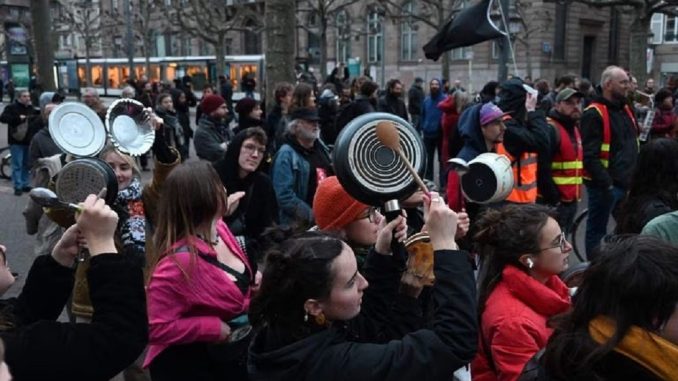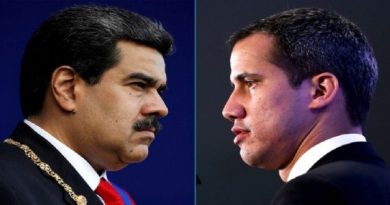France: the anti-reform struggle in a new moment
As soon as the Constitutional Council validated the pension reform of the French government on Friday 14 of April, That same night, President Emmanuel Macron promulgated it and in this way it would be in force since September. The Intersindical puts a stop to the protest and recently called to demonstrate on May 1. But the CGT, some unions such as the railway workers and the National Student Coordination call to "prepare the 1st" with strikes and marches for the days 20 Y 28.
ByPablo Vasco
Last Thursday 13 the twelfth national day of strike and mobilization took place. Both measures of force showed a lower level of participation than in previous days, but still, despite the wear and tear of three months of fighting, the salary discounts for the days of unemployment and the intimidating police force deployed by the government, several hundred thousand people took to the streets again across the country.
On Friday 14 the Constitutional Council, a reactionary institution of the French bourgeois-democratic regime, modified some points for the worse and validated the essentials of the anti-worker pension reform: raise the retirement age to 64 years and contributions to 43 years to be able to collect the full credit. In addition, the Council rejected the possibility of calling a popular initiative referendum, as proposed by some parties that seek to divert the street fight to the electoral plane to try to close the political crisis. Even with marked differences in the fight, since the center-left of Mélenchon (FI) He supported some actions and, on the other hand, the extreme right of Le Pen did not (RN), both political sectors focused on trying to get out at the institutional level via an uncertain referendum.
the same 14 there were protests in Paris and other 130 cities, some of whom suffered gas, sticks and police arrests. These actions were not called by the Intersindical, that has been showing a willingness to “dialogue” with the government, but the National Student Coordination (CNE), the revolutionary left, sectors of union activism and people joined spontaneously.
Although Macron had 15 days of term and anticipated that it would do so in 48 hours, in an arrogant attitude that same night he promulgated the reform. Monday 17, while speaking to the country on TV, there were cacerolazos of repudiation in dozens of cities. very cheeky, Macron said“listen to the rant” from town, promised to talk to“improve income” and a“better distribution of wealth”… but he ratified his anti-labor reform and anticipated a hardening against protests and immigration.
On Tuesday 18 there were protests by high school students prosecuted for having blocked their schools. And there will be a new strike and march for this Thursday 20, summoned by the railway Intersindical, with the support of the CGT and student coordination, and other measures of force for the 28. That is to say, in France the process of fighting against the reform has not yet been completed.
Why doesn't the reform fall?
It is the "million dollar question" that is debated between activism and beyond. France was shaken by twelve general strikes, very massive marches even in the smallest cities; company blockades, ports, faculties and colleges; harsh confrontations with the police... what was missing to defeat that reform, imposed by force of decrees 49.3 and that is rejected by the vast majority of the population? The answer lies in the key steering problem, whose role is to increasingly slow down the movement.
By the way, Macron and his Interior Minister Darmanin applied a violent repression that included special forces such as the CRS and the BRAV-M, arrests even minors, judicial injunctions against the strikers and threats of sanctions against anti-repressive organizations such as the League for the Rights of Man and the Collective Defense (Rennes) or the ecologist Los Levantamientos de la Tierra. But beyond such a repressive offensive, It is evident that there is plenty of will to fight from the working bases. The same in the student movement, that reorganizes, and in popular and middle sectors affected by inflation. The struggle also included important groups of workers with little or no union experience., who participated in the strikes and demonstrations for the first time.
Nevertheless, despite this enormous social force, with a higher rise than 2018 with the yellow vests since now the working class entered the scene, the bureaucratic leadership of the Intersindical was not up to what is needed. It was limited to a strategy of some pressure on the government, with days separated from each other by several days, but without ever advancing a plan of increasing strikes until an indefinite strike that would allow Macron to be defeated, his reform and his entire capitalist austerity plan. And now, in the best style of the CFDT, the trade union center most prone to class conciliation, it does not call anything for two weeks until May 1st.
The Intersindical also did not include the demand for a salary increase in the national agenda of struggle, that is so felt by the working class and that causes constant strikes. In March and April, for example, there were and are wage strikes in the children's clothing chain VertBaudet (Lille), Chavant's mail (Grenoble), the shipping company Genavir (Toulon and Brest), the Apple Store technology (paris and lyons), public transport (Narbonne, Tarbes, Loiret, Forbach and Tisseo-Tolosa), auto partisan ACS France (Two Sevres), the arrendataria Peninsula Habitat (Cherburgo), metalworker Gindre Duchavany (North-Isere), the SIVOM collector (Yerres), the sports channel AMP Visual TV and other companies.
Regarding a new union leadership, in Paris and other cities some interprofessional coordination arose, mobilization committees and strike pickets, port and warehouse blockades, all this driven by a radicalized youth activism and the revolutionary left. In some unions such as railway workers, energy, refineros, teachers and garbage collectors there were excesses to the bureaucracy and continuity of the strikes. In the last national congress of the CGT, for the first time, the balance of the leadership was rejected and there was a change. That same pressure from below forced the CGT to differentiate itself from the CFDT and that is why it calls for the strike and march of the 20 convened by the railway Intersindical with the support of the student coordination. But this process of organizing activism has not yet reached sufficient development and unity to constitute a national alternative to the bureaucracy of the Intersindical.
The tasks set
Faced with this new moment of the wrestling, more contradictory but from a process of struggle that is still open, there are two simultaneous challenges for revolutionary socialists. This is how the revolutionary wing of the NPA has been facing it (New Anti-Capitalist Party), in which our comrades from the LIS France militate:
- The first is to keep boosting all the fighting instances, self-organization and coordination of the combative sectors, like this thursday 20 in the strike of the CGT and the railway Intersindical. The objective is to strengthen a new alternative direction, of struggle and with workers' democracy, that allows to overcome the bureaucracy of the Intersindical. And the same in the student body, from the CNE.
- the second task, in the heat of mobilization, It is to continue building in the worker and youth vanguard a socialist and revolutionary political tool to dispute against all the capitalist and reformist variants that defend this system of exploitation and oppression. It is the only way to bring sooner rather than later a workers' and popular's exit for France, whose capitalist government, like their peers around the world, it is attacking each and every one of the rights of working people.




